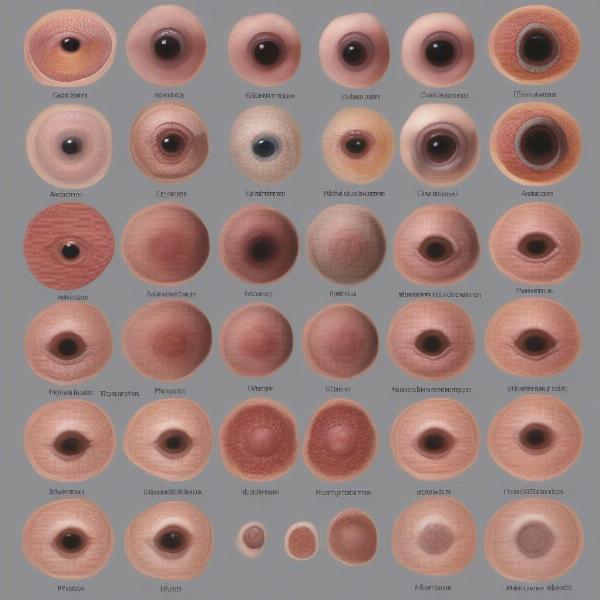Eyelid mass removal in dogs is a common surgical procedure performed to remove abnormal growths or masses that develop on the eyelids. These masses can range from benign cysts and warts to more serious cancerous tumors. Understanding the reasons for removal, the procedure itself, and post-operative care is essential for any dog owner facing this situation.
Types of Eyelid Masses in Dogs and Diagnosis
Several different types of masses can occur on a dog’s eyelid. These include:
- Meibomian gland adenomas (or adenocarcinomas): These are tumors originating from the Meibomian glands, which produce an oily substance that lubricates the eye. They are usually benign but can sometimes be cancerous.
- Papillomas: These are wart-like growths caused by a virus. They are generally benign and often regress on their own.
- Melanomas: These are pigmented tumors that can be either benign or malignant. Malignant melanomas can be aggressive and spread to other parts of the body.
- Chalazions: These are small, firm lumps caused by blocked Meibomian glands.
- Histiocytomas: These are benign, rapidly growing masses commonly seen in young dogs.
 Types of Eyelid Masses in Dogs
Types of Eyelid Masses in Dogs
Diagnosis involves a thorough examination of the eye and the mass. Your veterinarian may perform a fine-needle aspiration, where a small needle is inserted into the mass to collect cells for examination under a microscope. This helps determine the type of mass and whether it is cancerous. In some cases, a biopsy may be necessary for a definitive diagnosis.
Why is Eyelid Mass Removal Necessary?
Eyelid mass removal is often recommended for several reasons:
- Discomfort: The mass may rub against the cornea, causing irritation, pain, and excessive tearing.
- Vision impairment: Large masses can obstruct the dog’s vision.
- Cosmetic concerns: While not a primary reason, some owners opt for removal for cosmetic purposes.
- Prevention of spread: In the case of cancerous tumors, removal is crucial to prevent the spread of cancer to other parts of the body.
The Eyelid Mass Removal Procedure
Eyelid mass removal is typically performed under general anesthesia. The procedure involves carefully dissecting the mass from the surrounding tissue. Depending on the size and location of the mass, reconstruction of the eyelid may be necessary. This ensures proper eyelid function and protects the eye.
Post-Operative Care and Recovery
After surgery, your dog will be prescribed pain medication and antibiotics to prevent infection. An Elizabethan collar (cone) is essential to prevent your dog from rubbing or scratching the surgical site. Regular follow-up appointments with your veterinarian are necessary to monitor healing and ensure there are no complications. The prognosis for most eyelid mass removals is excellent, and most dogs recover fully.
What Happens if an Eyelid Mass is Left Untreated?
If an eyelid mass is left untreated, it can lead to various complications, including chronic eye irritation, corneal ulcers, vision loss, and, in the case of malignant tumors, the spread of cancer. Early diagnosis and treatment are crucial for the best possible outcome.
FAQs
- How much does eyelid mass removal surgery cost for a dog? The cost varies depending on the complexity of the procedure, the size and type of mass, and your geographic location. It’s best to consult with your veterinarian for an accurate estimate.
- Is eyelid mass removal painful for dogs? The procedure itself is performed under general anesthesia, so the dog feels no pain during surgery. Post-operative pain is managed with medication.
- How long does it take for a dog to recover from eyelid mass removal? Most dogs recover within a few weeks, but complete healing may take longer.
- Are eyelid masses in dogs always cancerous? No, many eyelid masses are benign, but it’s essential to have them evaluated by a veterinarian to determine the type and appropriate treatment.
- Can eyelid masses in dogs recur after removal? While less common, some types of masses can recur. Regular checkups are essential for early detection and treatment.
- What are the signs of an eyelid mass in a dog? Common signs include swelling, redness, discharge, squinting, pawing at the eye, and visible lumps or bumps on the eyelid.
- When should I take my dog to the vet for an eyelid mass? Any new lump or bump on your dog’s eyelid should be evaluated by a veterinarian as soon as possible.
Related Articles
About ILM Dog
ILM Dog (ilmdog.com) is your trusted global resource for expert dog care advice. We offer comprehensive, practical information on dog breeds, health, training, nutrition, grooming, and much more. From puppy care to senior dog support, we empower dog owners worldwide with the knowledge they need. Whether you’re a seasoned dog owner or just starting your journey, ILM Dog is here to help you provide the best possible care for your furry friend. Contact us at [email protected] or +44 20-3965-8624 for personalized advice and support.